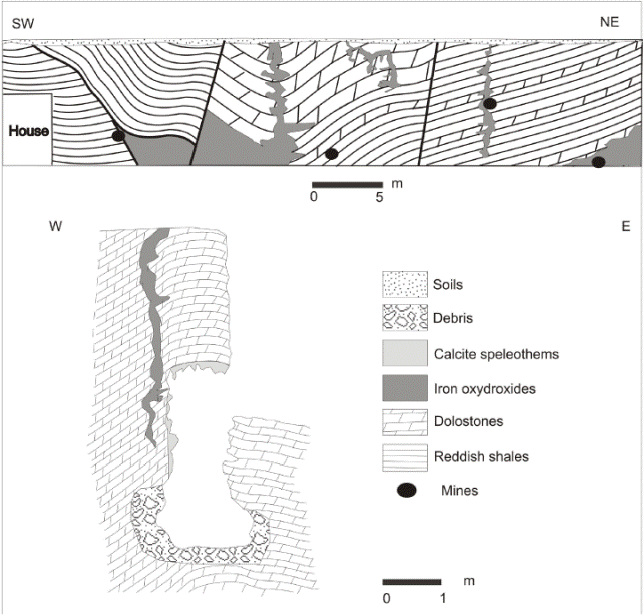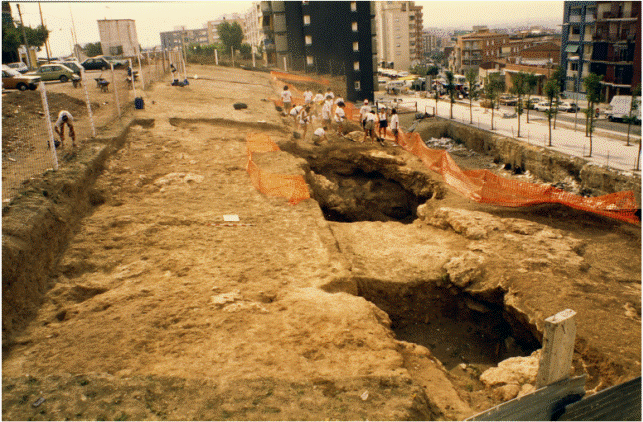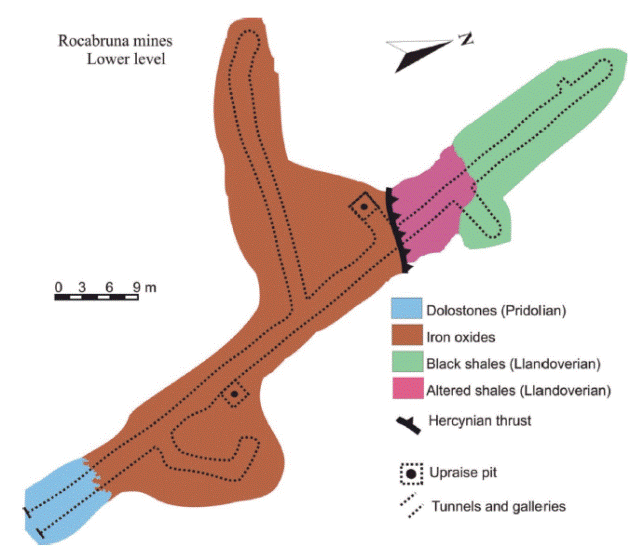1. Introduction
The Iberian culture settled along the Mediterranean coast between the southeastern part of the Iberian Peninsula and southeastern France between the sixth century BC and the third century AC. Many small cities and towns of this period are found along the coastal area of Catalonia (Belarte et al., 2001; Sanmartí, 2014). This period represents the Iron Agein this area, and the existence of iron mines was a key factor for the development of many settlements nearby.
Iron deposits of many different styles, such as skarns, hard grounds, and karstic deposits, are found along the Catalan Coastal Ranges (CCR) (Figure 1). Some of the iron deposits, according to archeological evidence, were mined in the Iberian towns of Les Guàrdies near El Vendrell, 60 km SW of Barcelona (Asensio et al., 1996), and Fontscalents near Castellar del Vallès, 40 km N of Barcelona (Coll et al., 1993). Many others were mined during the Middle Ages, like the Els Crossos mines located in a magnetite skarn deposit near Les Borges del Camp, 120 km SW of Barcelona (Jové, 1981), and during the nineteenth century, as the Fontscalents mines that were exploited again (Planas and Portolés, 1995). Among karstic deposits, those of Gavà have the best outcropping conditions, favored by intensive mining and archeological excavations. Therefore, these mines allow studying the iron deposits as a representative of the karstic iron deposits in Catalonia.
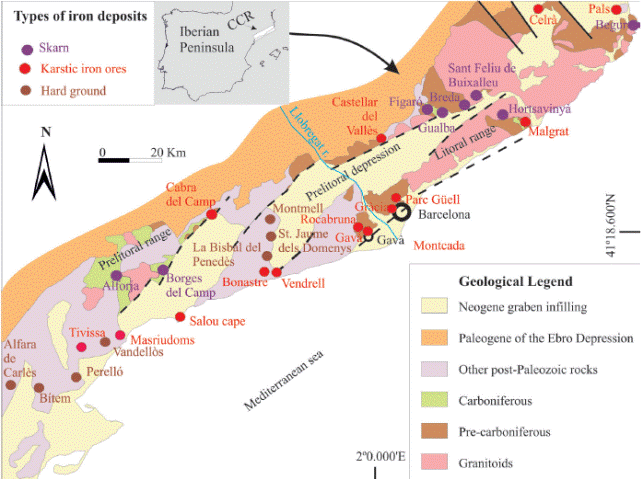
Figure 1 Geological map of the Catalan Coastal Ranges (CCR), with the distribution of the known iron mines and outcrops with archaeological interest.
The Gavà area is famous worldwide for the existence of ancient Neolithic mines (Alonso et al., 1978; Villalba et al., 1986, 1989, 1990; Blasco et al., 1991; Camprubí et al., 1994, 2003; Costa et al., 1994; Bosch et al., 1996; Villalba, 2002; Díaz-Acha et al., 2019) and the important archeological objects found therein, such as the Gavà Venus (Bosch and Estrada, 1994) and variscite ornaments (Borrell and Estrada, 2009). However, many other types of mining operations for iron exist in the same area, in many cases in the immediate vicinity of the Neolithic works and separated from them by only tens of meters. The archeological objects, such as pottery, found inside these mines, and some absolute carbon dating, established that no less than 16 of these mines were active during the Iberian and Iberian-Roman periods (Villalba and Alonso, 1984; Burjachs et al., 1991; Molinàs, 2007; Álvarez and Estrada, 2009; Bordas et al., 2009, 2010). There are evidences of other small open-shaft operations of these iron ores, during the Middle Ages (Campmany et al., 2004) and the Modern Age (Bordas et al., 2009), but the largest mining operation on these ores was developed during the industrial era since the mid-nineteenth century (Maureta and Thos, 1881) and reworked during the early twentieth century). The last stages of mining produced open pit extractions and large galleries, as in the case of the Elvira mines in the Rocabruna range, NW Gavà (Maluquer, 1905; Bareche and Viñals, 1994). The Rocabruna mines were probably worked since antiquity. However, large-scale modern mining destroyed any evidence of earlier exploitation. There are two essential points those agree with the fact that these mines were exploited in Antiquity: the outcrops of iron ores are larger than any other known Iberian or Iberian-Roman settlement in Catalonia and, as already mentioned, mining existed in this specific area (the Les Ferreres range and the Can Tintorer complex) since the Neolithic.
The aim of this contribution is to describe the geological context of the Gavà iron ores and their genetic model, particularly of those iron ores found in the archeological sites, in order to understand how the Iberian and Iberian-Roman population might have used these natural resources.
2. Geological background
The study area is locatedin the central part of the CCR. The CCR are classically divided in two NE-SW-trending ranges (Prelittoral and Littoral) separated by the Prelittoral depression (Anadón et al., 1979). These geological units are separated by regional faults which acted as NE-SW strike-slip faults during the Alpine compressive event (Paleogene) and as normal faults during the Neogene, thus generating alternate faults and associated grabens as well as the present coastline (Anadón et al., 1985a). The study area lies in the Littoral range, where a Paleozoic metamorphic basement is unconformably overlain by Mesozoic sedimentary rocks. All of them are covered by Quaternary sediments towards the SE (Costa et al., 1994).
The iron deposits in the CCR are generally found in the Paleozoic basement. The stratigraphy of the Paleozoic basement has been studied in detail in the areas near Barcelona (Julivert and Duran, 1990a; García-López et al., 1990, 1996). The Paleozoic series starts with Late Ordovician orthoquartzites overlain by 100 m of interbedded black shales with cherts and alkaline volcanics of Llandoverian age, 50 m of black shales with interbedded thin quartzites (Wenlockian), and 50 m of black shales (Ludlowian). This unit is overlain by La Creu Formation which is 30-40 m thick and it is made of Pridolian nodular limestones (Julivert et al., 1985). These limestones are conformably covered by the Olorde unit, which starts with 2-3 m of Lower Lockovian black shales overlain by an interbedding of limestones and reddish shales (Middle Lockovian) that grades to green to bluish marls with carbonate nodules (15-20 m thick, Upper Lockovian) and limestones that alternate with shales (10-15 m thick, Pragian). The series at the top consists of green marls. The contact with the Carboniferous materials (Figure 2) has not been established in the area because all the contacts are tectonic. However, they are described at the southern part of the study area as black cherts (“lidites”) of Tournaisian age and greenish graywackes of the Visean (Anadón et al., 1985b).
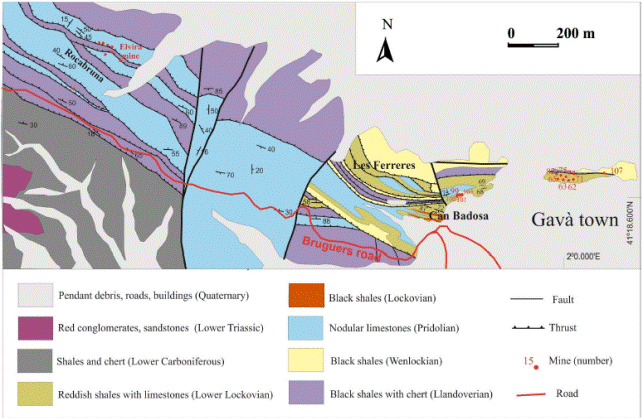
Figure 2 Geological map of the Gavà-Rocabruna area with indication of the iron mines and iron outcrops of this sector.
The Hercynian deformation largely affected the Paleozoic series of the area. It is described in the CCR domain by Julivert and Duran (1990b). A first stage of deformation produced NW-SE tight folds with the axial planes dipping to the NE. These folds have thrusts and retrothrusts on their flanks, and the black shales are the most common detachment level. A second phase of deformation produced folds with similar axial direction but opposite vergence. These folds can also contain detachments in the flanks. The deformation took place in the epizone, and axial-plane foliation is poorly developed. There is a very low-grade regional metamorphism. Contact metamorphism is absent in the study area, owing to the lack of Hercynian intrusives in this sector of the CCR. However, the Hercynian thrusts were associated with low-temperature hydrothermal circulation, which is more evident in Silurian and Devonian dolomitized-ankeritized limestones. The resulting rocks are yellowish to brownish and consist of ferrous saddle dolomite or ankerite, with crystals up to 2 mm in diameter. In addition, these rocks may contain disseminated pyrite with cubic crystals about 500 µm in size, but in some cases they constitute nodules up to 3 cm in diameter. The sulfide content in these rocks rarely attains ~1% modal.
The Paleozoic rocks are unconformably overlain by Triassic sedimentary rocks that dip gently towards the SW (IGME, 1976a, b). The Triassic series starts with a thick (more than 100 m) Early Triassic detrital Buntsandstein facies that starts with conglomerates followed by sandstones and clays (Virgili, 1958). This is followed by about 50 m of limestones and dolomites of the Lower Muschelkalk facies (Calvet and Ramón, 1987), 50 m of red clays and gypsum of the Middle Muschelkalk facies (Morad et al., 1995), and 50 m of limestones, dolostones, and marls of the Upper Muschelkalk facies (Calvet et al., 1987). Towards the SW the materials are covered by thick series of Jurassic and Cretaceous carbonates of the Garraf basin (Salas, 1987; Albrich et al., 2006). Large lull episodes in sedimentation favored the development of hard ground mineralizations along the stratigraphic profiles of the Mesozoic sediments.
The Paleozoic rocks are unconformably overlain by the Paleogene series, which in the base start as continental rocks that can be related with the development of karstification and Fe-Mn mineralization in the underlying materials. These were followed by evaporitic and marine series that correspond to the transition with the marine series of the Ebro basin.
The Alpine deformation, as in other regions of the CCR, produced a dense network of Oligocene transpressive faults that strike mainly NE-SW and NW-SE, thus resulting in complex block movements in the area (Guimerà, 1984). Several sets of subvertical joints, related with such faults, are widely distributed and affect all the materials in the area, in particular the dolostones. These joints represent good pathways for fluid circulation. Most transpressive faults were reactivated during the Neogene extension as normal faults, thus producing a compartmentalization of pre-existing blocks into horsts and grabens. The syntectonic sediments associated with this stage are mainly conglomerates due to graben infilling, along with sands and clays. Some Fe-Mn karstic mineralizations can also be associated with this episode.
During the early Pleistocene, weathering produced strong changes in the outcropping materials of the Paleozoic basement. Pyrite-bearing black shales were oxidized, and the resulting acidic and oxidizing fluids leached off the organic matter in the black shales. As a result, these rocks turned pale grayish near the surface, and typical sulfates and phosphates of the alunite supergroup were formed. These minerals were dated at 1.2 and 1.3 Ma (Calabrian/Villafranchian; Camprubí et al., 2003). Weathering also affected Paleozoic Fe-rich carbonates, thus producing karstic iron replacements (Costa et al., 1993) that were favored by jointing in the dolostones.
The Quaternary sediments are more common in the lowest part of the range, near the plain associated with the Llobregat River (Figure 1). Unconsolidated gravels are common in the flanks of the mountains, and sequences of calcretes, sedimentary clay deposits, and breccias can be found near the border between Paleozoic rocks and the graben (i.e., Solé-Benet et al., 1988; Casassas and Riba, 1992). The Llobregat delta plain consists of river terrace and flood plain deposits, and Pleistocene-Holocene paleochannels (Daura et al., 2013).
The iron mines in the Gavà area strike NW--SE along a 2 km stretch section, between the Gavà town and the Bruguers chapel, 20 km west of Barcelona in Catalonia (Figure 2). Many of these mines were destroyed during the dense urbanistic operations of the 1960s- decade. However, in recent decades, the municipality of Gavà and the Catalan government enforced the study of all old mines in the area and, in many cases, the preservation of the Neolithic and Iberian mines. In this particular case, the Can Badosa area, which is an urbanistic polygon around an old farm in the Les Ferreres range, at the NW corner of the town of Gavà, comprises both Neolithic variscite mines and Iberian to modern iron mines. The archaeological excavations in recent years allowed the study of many of these mines, but many of the recently discovered Iberian mines are now covered by buildings and no further studies are possible anymore.
3. Methods
Samples were studied using thin polished sections by transmitted and reflected light optical mineralogy, coupled with X-ray powder diffraction (XRD). The XRD measurements were performed using a Bragg-Brentano θ/2 Siemens D-500 diffractometer (radius = 200.5 mm) with Cu Kα radiation, selected by means of a secondary graphite monochromator, and a NaI(Tl) scintillation counter. The divergence slit was 1° and the receiving slit 0.05°. The starting and the final 2θ angles were 4 and 70°, respectively. The step size was 0.05° 2θ and the measuring time was 3 seconds per step.
The analyses were performed at the Scientific and Techcnological Centres of the University of Barcelona (CCiTUB).
4. Styles of iron deposits in the Gavà area
Iron deposits in the study area were developed by replacement of three rock ensembles, which control the morphology and volume of the deposit as well as its resulting mineralogy: (a) deposits developed on weathered profiles in carbonates of the La Creu Formation (Pridolian), (b) deposits developed on weathered profiles in carbonates interbedded with shales of the Ludlow-Pridolian transition or within the Olorda Formation (Lockovian-Pragian), and (c) deposits in weathered profiles on carbonates overthrusted by Silurian shales.
4.1. Deposits in weathered profiles on the La Creu Formation (Pridolian)
The Pridolian carbonate rocks were strongly dolomitized or even ankeritized (Figure 3A), and easily affected by supergenic processes in their surface exposures. Also, some limestones were rich in pyrite nodules that underwent oxidation (Figure 3B) and produced supergenic acidic fluids. The replacement progresses along any discontinuities, either sedimentary (stratification surfaces, in particular when the beds are subvertical), or structural (joints, thrusts, faults). In particular, joints were effective in favoring supergenic processes due to their penetrativity in dolomites. Further, dolomite rocks have additional porosity that was associated with the dolomitization processes, which increased the likeliness for these rocks to react with supergenic fluids. The supergenic mineralization is scarcely developed in depth and was confined to the first 3 to 5 m from the paleosurface, nonetheless. The morphology of the contacts between the mineralization and the host carbonates clearly corresponds to replacement processes and are irregularly shaped.
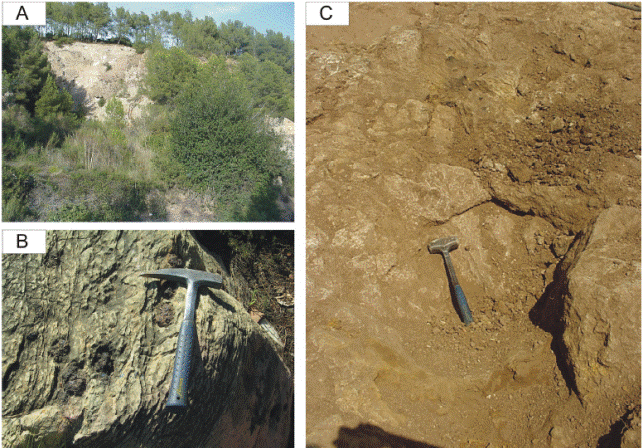
Figure 3 General aspects of the geological context of karst in Pridolian carbonates. (A) Dolostones (pale gray) replaced by ankerite (dark gray) in a quarry, 1 km NW of Gavà. (B) Dolomitized limestones (light gray) with pyrite nodules pseudomorphosed by goethite (dark brown). (C) Detail of the irregular replacement of the ankeritized limestones by iron oxides (black and yellow) near Can Badosa.
The iron oxide ore bodies occur as lenses, pipes, and pods. In most cases, lenses are developed along joints. The mineralized areas have a roughly lensoidal shape that are only a few centimeters wide on either side of the joints, but rarely up to 3 m wide. The length of these lenses is less than 15 m, generally 2 to 3 m long. The pipes were usually formed along the intersection of two systems of joints or along the intersection of a joint and other types of discontinuity, such as faults or vertical stratification surfaces. Pipes are subvertical and their diameter varies between a few cm and 3 m. Pods are very irregular and are generally located on the surface or in its vicinities. Their formation was probably favored by the intersection of three or more discontinuities in the rock. In fact, non-outcropping bodies appear to occur in the path of pipes or lenses from the surface. The size of pods is highly variable, but always less than 5 m in diameter.
The mineral filling started with a short period of calcite precipitation that could represent speleothems. The next stage may contain breccias, which are cemented by mixtures of cryptocrystalline goethite and hematite with minor amounts of wad. Therefore, the color of the ores may vary among different hues of yellow, brown, red, or black, hence their labeling as “ochres” following the definition of Elias et al. (2006). The breccias grade laterally and vertically to massive aggregates of these minerals. These minerals are usually arranged in boxwork textures when replacing iron-rich carbonates and the accompanying pyrite, and botryoidal textures are also common in these circumstances. However, in most cases, ore bodies are unconsolidated earthy masses of hydrated amorphous iron oxyhydroxides (“limonite”), mixed with cryptocrystalline goethite, hematite, and jarosite. Sedimentary textures and pisoliths are absent in these deposits. Late calcite veinlets and speleothems may occur in some deposits onto the remaining iron oxide ores left after their exploitation, thus pointing to a very recent formation.
Some representative ores of this type were found in the Can Badosa, area when excavating the foundations of a building in the immediate vicinity of the Neolithic mines. This type ofiron ores were locally mined (Figure 3C).
4.2. Deposits in weathered profiles on carbonates interbedded with shales
As in the previous case, some examples of weathered profiles on carbonates interbedded with shales deposits were found at the foundation of a building in the Can Badosa area (Figure 4). These deposits occur in the Lockovian series but have many similarities with others found in the transition unit between the Ludlovian shales and the Pridolian carbonates. In all cases the host rocks are thin limestone lenses interbedded within pyrite-rich shales, that may be interbedded with phosphate beds as well, made up with cryptocrystalline fluorapatite. Therefore, the altered rock is geochemically more complex than in the previous style and the resulting ores after weathering contain abundant silicates and phosphates. The deposit is mainly controlled by bedding surfaces as the most suitable channels for water infilling but also by joints, thus resulting in pod-shaped ore bodies (Figure 4).

Figure 4 General aspects of the iron ores developed by alteration of carbonates interbedded with shales in the Can Badosa area. (A) Meter-thick altered dolostone beds (pale gray) interbedded with shales (dark). Note the mine at the right-hand side, partly shut. (B) Pervasive replacement of the shale and carbonate rock ensemble by iron oxides (yellowish and dark brown). Note some mine workings on the left-hand side.
The Lockovian carbonate beds are also replaced by dolomite and ankerite, and weathering produces similar mixtures of oxyhydroxides and cryptocrystalline goethite, hematite, and jarosite as in the Pridolian limestones. However, the shales were enriched in pyrite and the resulting acidic fluids would have reacted with illite from the associated shales, which resulted in iron ores with relatively high silica contents in the form of opal. With higher degrees of replacement of the protoliths, the resulting ores may become massive, up to 10 m in diameter pods with high iron oxides and opal contents. In other cases, the ore bodies are roughly tabular in shape and a few centimeters thick, as they mimic the shape of the replaced carbonates. In the cases where this process occurred in rocks with carbonate/shale ratios above 1, the mineralization became almost massive and consists of a mixture of iron oxides, quartz, and illite or kaolinite. This style of mineralization occurs in the form of cryptocrystalline or even earthy aggregates, and consists mainly of goethite and “limonite”-type mineral mixtures.
4.3. Deposits in weathered profiles on carbonates overthrust by Silurian shales
A significant example of this style is represented by the deposits in the Rocabruna area (2 km NW of Gavà; Figure 1) in which large volumes of iron oxyhydroxides were formed. The Pridolian limestones were overthrusted by Silurian shales and supergenic alteration processes affected both lithologies (Figure 5A). This scenario resulted in a higher mineralogical and structural complexity than in the above mineralization styles. The main reason for this is that large volumes of carbonate rocks were fully replaced in the proximity of thrust surfaces. The resulting oxyhydroxide deposits are massive and irregularly shaped, and their size is on the order of hectometers in all directions. The distribution of massive ores is basically restricted to replaced carbonates, but minor enrichments are found in altered shales.
The oxyhydroxide ores in this style of deposits are rich in different types of phosphates (Costa et al., 1993), in particular Fe-Ca phosphates as white botryoidal hydroxylapatite [Ca5(PO4)3(OH)], greenish microcrystalline calcioferrite [Ca2Fe3+ 2(PO4)3 (OH)·7H2O], yellowish cryptocrystalline tinticite [Fe3+ 5.34(PO4)3.62(VO4)0.38(OH)4· 6.7H2O] (Bareche and Viñals, 1994; Camprubí et al., 1994; Melgarejo et al., 1988; Rius et al., 2000; Diez and Rosell, 2013), and reddish cryptocrystalline dufrénite Ca0.5Fe2+Fe3+ 5(PO4)4(OH)6· 2H2O (Tritlla, 1987). These phosphates formed in a late stage and occur either as nodules or veinlets filling small cracks across the goethite bodies, mainly along 2 m below the contact with the Silurian shales (Figure 5B). Moreover, jarosite is a common mineral in the contact between the thrust shales and the ore bodies, and is found forming yellowish or greenish cryptocrystalline massive aggregates (Figure 5C) that can be associated with calcioferrite, tinticite and dufrénite. Alunite is also found as white, earthy cryptocrystalline masses along the thrust contact (Figure 5D; Camprubí et al., 2003). The oxide ores are the same as those described in the Can Badosa mines and show the same textures. The occurrence of carbonate minerals is less common in this style of mineralization than in the previous two.
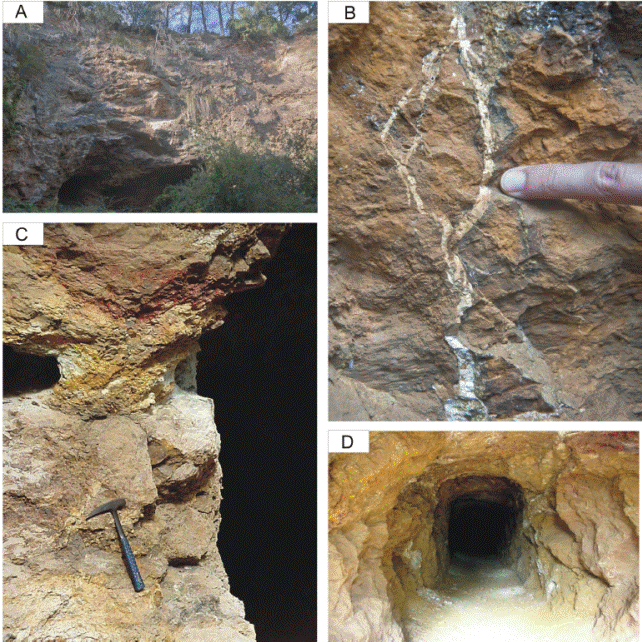
Figure 5 Field aspect of the massive iron ores developed on Pridolian carbonates overthrusted by pyrite-rich Silurian black shales at the Rocabruna mines, Gavà. (A) Top of the Rocabruna quarry, with the overthrust altered shales, enriched in iron ores. (B) Tinticite veins (yellow) cutting massive goethite bodies produced by replacement of ankeritized Pridolian limestones. (C) Subhorizontal contact between the overthrust shales (strongly replaced by goethite, upper half of the image) and the Pridolian carbonates replaced by goethite (dark brown, lower half of the image). (D) Alunite intergrowths (white coloured) crystallized over the thrust surface that roughly follows the top of the mining gallery. The lower part of the image shows entirely massive iron oxides.
4.4. Distribution of iron mining operations in the Gavà area
The geological mapping of the area combined with bibliographic research and archeological studies performed during the urban developments in the last 30 years allow the identification of more than 50 old iron mines in the Gavà municipality. The mines occur within a 2 km long and 0.5 km wide belt between Gavà and Bruguers, NW of Gavà (Figure 2). There are two main mining areas concentrated at the Les Ferreres range (the “Ironworks” range) and the Rocabruna area (the “Brownish Rock” area). This toponym is related to the brownish color of iron-rich rocks and is typically used for areas with iron mines in Catalonia since the Middle Ages.
The geological study of most of the iron mines was performed as the archeological excavations progressed. This aspect was important in order to discriminate between the Neolithic variscite mines (see Díaz-Acha et al., 2019) and more recent iron mines, especially where both types of mines occur nearby each other. Both artisanal and industrial mineral operations can be recognized in Gavà. It is not clear, however, whether industrial mines were developed in areas that were previously mined in an artisanal manner. All the exploitations were developed on altered carbonate-bearing rocks (Figures 4 to 6).
5. Description of the mining operations
5.1. Artisanal mining in the Can Badosa area
One of the first Iberian mining operations, discovered in Gavà, was mine 65 (Figure 2 and 7), which was minted during the rule of the Roman emperor Trajan. This mine has been dated between the I and II centuries AD based on a coin found inside the mine. (Arenas et al., 1989; Álvarez et al., 1991). This mine consists of a large trench (16.5 m long and 5.3 m wide). A small prospecting pit (mine 63, interpreted as older than mine 65) was found in its proximity. Similar open pits were found thereafter during archeological excavations (i.e., mine 82; Estrada and Bosch, 1997), and some of the outcrops of the southern part of Can Badosa represent this style of mine operations (Figure 3C).
A large number of small artisanal operations (mines 97-101, 103-105) were found when constructing the foundations of a building near Pompeu Fabra Avenue on the outskirts of Gavà. Many small karstic cavities were found in the study area, but they do not show credible evidence for historical mining operations. Most of the artisanal mines were developed as vertical pits and, therefore, are filled with natural debris. Although many of the mines have not been completely excavated, they have been sealed and protected in order to facilitate future archeological research. These mines consist of small pits (1 to 3 m deep) that were dug directly on outcropping ore bodies (i.e., mine 105 in Figure 6). These pits can give access to short galleries, less than 3 m long. The galleries and pits section tends to be rounded and it is less than 1.5 m in diameter, However it galleries are generally irregular because the miners carefully extracted as much as possible the iron ores. Therefore, the extraction of ores and the general work inside these mines was complicated, and the geometric characteristics of some of the mines suggest that they were probably exploited by children. After the extraction of iron ore, some mines experienced water infiltration that produced the development of calcite speleothems (Figure 6).
5.2. Artisanal to industrial mining in the Rocabruna mines
Campmany et al. (2004) describe historical documents about the mining activity and the ore processing by the Catalan forge system in the area during the Middle Ages. The forges were located both in Gavà and Bruguers; hence, the forges were most likely fed by material extracted from the Rocabruna mines. The oldest activity registered in the area corresponds to the year 1068. At that time the area was near the frontier between the county of Barcelona and Al‒Andalus, and was considered a territory in conflict. Therefore, the products of the iron mines and the associated forges could have had a strategic importance in war. The mining and forge activities continued at least during the twelfth and thirteenth centuries, and ceased at the end of the Middle Ages (Campmany et al., 2004). The Rocabruna mines were reopened in 1770 and ceased again shortly thereafter (Campmany et al., 2004). There is no data about the exploitation system during this period, but the ore bodies were probably exploited by means of trenches.
During the period 1860-1861 the mines were reopened to furnish iron mineral to a forge at Sants (Bauzá, 1861), today a district of Barcelona. During this period the mines were exploited by open pits of reduced dimensions (less than 50 m in diameter, Figure 5A), but the mining company went bankrupt and mining ceased (Bauzá, 1861). New operations using small open pits were performed in other iron outcrops of the area during the period 1876-1878. The mines were exploited once more following the same system during the period 1888-1908 and at that time the mineral was exported to be processed in France (Maureta and Thos, 1881). However, the dimensions of the mines exploited between the nineteenth century and the beginning of the twentieth century allows estimating a production of less than 50000 tons in total.
The last and more important period of activity of these mines was during the autarchy period of the Francoist dictatorship, during the 1940s and 1950s, at the end of this period mining ceased definitively in the area (Campmany et al., 2004). During this period some horizontal tunnels were built starting from the bottom of the open pit (Figure 8). One of the tunnels gave service to a large stope to exploit the iron ores. A gallery of reconnaissance started from the stope (gallery 1 in Figure 8) and found small irregular pods of ore replacing dolostones at the contact with Hercynian thrusts, but the replacement of carbonate rocks was only partial and therefore the distribution of the ore was very irregular, and the gallery was subsequently closed. Other exploratory galleries were planned without geological criteria. For instance, the gallery starting at the adit 2 (Figure 8) also found ore, but the exploitation did not continue entered the black shales .
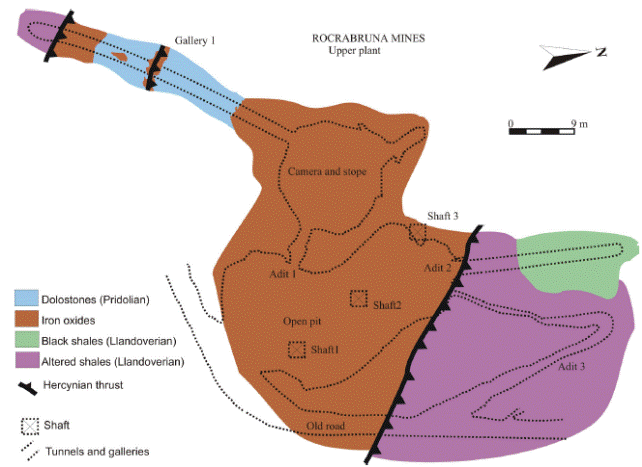
Figure 8 Open pit of the nineteenth century, and upper levels of the 1940s mining works, at the Rocabruna mines. Notice the control on the location of ores exerted by Hercynian thrusts.
The mineral obtained from these galleries was sent through shafts to a lower plant mainly used for mineral evacuation. This lower plant consisted of an access tunnel with some lateral galleries for ore reconnaissance (Figure 9). The continuity at depth of the ore bodies was demonstrated in these galleries but they never were exploited at this level. The mineral was extracted through the adit of this mine and sent to the processing plant.
6. Discussion
6.1. Formation of iron ores in the Gavà area
The iron ores in the Can Badosa-Les Ferreres range area are essentially hosted by Pridolian massive limestones, which are the main guides for finding old iron mines in the Gavà region (Costa et al., 1993). Also, some artisanal works were established on minor deposits that are hosted by dolostones interbedded with shales of the Silurian-Devonian transition. The outcrops of the carbonate rocks are not continuous and the Paleozoic tectonic structure in the area is complex. The limestones are segmented because of thrusting and Alpine faults, factors that limit the development of large deposits.
The morphology of the iron ores at Can Badosa corresponds to vertical karstic shafts and small chamber rooms, following the terminology of Loucks (1999). These deposits were formed by replacement of the carbonate rocks within the vadose zone near the Quaternary paleosurface. This domain is not able to produce large cavities in the karstic realms (Loucks, 1999). The volume of individual iron ore bodies in the study area is limited in most cases due to the small thickness of carbonate beds or by the low amount of available iron in these rocks. Therefore, these deposits do not meet the current economic criteria for industrial mining operations, but their mining would have been feasible by artisanal exploitations, as shown by those mines active during the Iberian and Roman times, and during the Middle Ages.
All the iron oxyhydroxide deposits in the study area are karstic in origin (common around Barcelona), similar to those described in many locations along the CCR (Mata-Perelló and Montoriol-Pous, 1975; Mata-Perelló, 1990). These type of iron mines were exploited in industrial times without significant profit. Other iron deposits, also developed on weathered limestones, are found in the vicinity of El Vendrell (60 km SW of Gavà). These deposits also have reduced dimensions and were also exploited during the pre-Roman Iberian epoch (Morer and Rigo, 1999).
The formation model for iron deposits along the CCR is variable. A sedex-type origin was proposed for the Malgrat iron mines near the Catalan coast (Carmona and Viladevall, 1983, 1985) and an epithermal origin was suggested for the Celrà iron mines in NE Catalonia (Ferrer-Modolell, 1991). However, the irregular morphology produced by replacement, the botryoidal and earthy textures, and the poorly crystalline character of most iron ores of the CCR suggest that these deposits were produced by edaphic processes, in part coupled with karstic development. The controls of the ores are lithologic (availability of iron-rich carbonates), paleogeographic (proximity of the Quaternary paleosurface, less than 5 m deep), and structural (presence of discontinuities as joints and faults).
The Can Badosa karstic deposits could be classified as immature, as the karst was developed by fluids, circulating vertically by gravity, within the vadose zone (as described by Loucks, 1999). The Can Badosa and Rocabruna deposits exhibit significant mineralogical differences between them, such as the occurrence of minerals of the alunite supergroup and iron phosphates in Rocabruna, which are absent in Can Badosa. Also, the deposits are much larger in the Rocabruna than in the Can Badosa group of deposits.
The occurrence of large amounts of alunite and jarosite in the Rocabruna deposits is a key factor to recognize the effects of acidic fluids involved in the genesis of the deposit and to explain its size and grade. A hydrothermal origin is not an exclusive source for acidic and oxidizing fluids, and such solutions can be produced by weathering below paleosurfaces of sulfide-rich rocks (Melgarejo et al., 1997; Borruel-Abadía et al., 2016), a role that is played effectively by the overthrusting Silurian shales in the study area. Weathering processes may develop economic deposits of alunite-group minerals, such as those developed on similar Silurian black shales in central Spain (Caballero et al., 1974; Cañada, 1974). Such processes may also produce economic iron oxyhydroxide deposits on the surface, as is the case of the Riaza deposits in central Spain (Leal-Meca and Lillo-Ramos, 2009). Therefore, the acidic oxidizing fluids that result from the oxidation of pyrite are able to transport leached iron towards deeper parts of the weathering profile where, in the case of the studied deposits, Pridolian carbonates were found. The neutralization of the acidic fluids when reacting with the carbonates would have produced (1) the precipitation of sulfates of the alunite group at the contact between the shales and the carbonate rocks, and (2) the replacement of iron-rich carbonates and precipitation of iron oxyhydroxides at higher pH and below the contact. Therefore, the sources of iron at the Rocabruna deposit could be both the iron coming from the dissolution of Fe-rich dolostones and the iron transported by the descending supergenic acidic fluids, whereas the likeliest source of iron in the Can Badosa deposits would be the dissolution of Fe-rich dolostones alone. Consequently, the downward incorporation of acidic fluids helped to produce larger deposits at Rocabruna than in Can Badosa by increasing the replaced volume and supplying additional Fe. Moreover, the dissolution of apatite in the overthrusting Silurian shales by acidic fluids is responsible for the formation of descending H3PO4-enriched fluids, which would have reacted with Ca-Fe carbonates and oxyhydroxides to form iron-rich phosphates.
The existence of deep weathering profiles suggests that these deposits were formed under a humid climate. Dating of the alunite associated with supergenic ores in the Gavà area yielded Calabrian-Villafranchian ages (late Pliocene; Camprubí et al., 2003). These ages are in accordance with palynological studies in sediments from other areas of Catalonia, which suggest that the climate during the early to middle Pleistocene was warm and humid (Postigo Mijarra et al., 2007).
Iron ore deposits in paleokarsts have been intensively mined worldwide between prehistoric times and the nineteenth century because they were highly suitable for metallurgical extraction of iron (Bárdossy et al., 2015). In some cases, as in Belgium, the richest deposits occur in deposits similar to Rocabruna; that is, limestones overthrust by shales (Denayer, 2016). In fact, pre-existing concentrations of iron ores are considered necessary to produce large iron deposits by supergenic processes, as proposed to explain the iron enrichments in the large mines of Marquesado, Alquifes and Las Piletas near Granada, southern Spain (Torres-Ruiz, 1983).
6.2. Conditions for early iron mining in the Gavà area
The morphology and mineralogy of the deposits are crucial factors that control the feasibility of exploitations through history. The existence of relatively soft oxyhydroxide ores, similar in texture and mineralogy to those classically known as “bog ore”, could have favored artisanal mining between the Iberian and Roman historical periods. Such is the case of many other locations in Europe during pre-Roman times (i.e., Thelemann et al., 2017). The porous nature of the ores could have favored reducing reactions (Tylecote, 1992) as such as ores were suitable for iron reduction in bloomery (i.e., Sauder and Williams, 2002).
The studied iron mines were near populated centers since the Iberian period. Despite the reduced dimensions of the mined ore deposits, these could have been large enough to feed the local demand within a subsistence economic scheme. Therefore, such ores would have supported the sort of mining operations that could be developed during the Iberian or Iberian-Roman periods, and such a possible age for the earliest iron mining in the region is also supported by archeological evidence (Arenas et al., 1989; Álvarez et al., 1991). Also, the forges that would have been fed by mining activities in these ores were active during the Middle Ages, as documented by Campmany et al. (2004).
Some of the oldest mines in Europe were opened to exploit iron ochres for pigments, such as a mine in Greece that was dated at 2,000 BP (Levato, 2016). The studied iron mines share the same geological context and mineralized areas with the Neolithic variscite mines of Gavà, which makes a strong case for both types of mines to be exploited simultaneously, although there is no convincing evidence for mining of iron ores in the Gavà area earlier than the Iberian period.
The Can Badosa iron ores are silica-poor in the Pridolian carbonates, but silica-rich in the Lockovian carbonates. The silica-rich ores would have hindered the Iberian period metallurgy by generating large volumes of slag. The Rocabruna ores, with high contents in phosphates, could have produced lower quality metal objects that would have been harder than P-poor objects but slightly more brittle (Sarabia, 1994).
7. Conclusions
The iron ores of the Gavà domain were formed by karstic processes developed during the late Pliocene and the Quaternary on Fe-rich dolostone units of Silurian-Devonian age. The dimensions of these deposits are quite reduced owing to the scarce thickness of the Paleozoic carbonates and the compartmentalization of the outcrops by their structural arrangement.
The ore grade decreases with increasing silicate content in the protolith (Lockovian or Ludlovian) due to interbedding between carbonate rocks and shales. Also, the ore size and grade ores increase, and the mineralization become massive, when carbonates were replaced by acidic fluids due to the oxidation of pyrite in overthrusting pyrite-rich shales.
Karstic ores consist mainly of cryptocrystalline goethite and hematite, often as unconsolidated aggregates. Such textures and mineralogy favored artisanal mining of these ores during antiquity.
Archeological evidence indicates that all the styles of iron ores in the Gavà area have been exploited at least since the Iberian historical period. Iron mining has been intermittently active in this area through history, essentially during the Roman epoch, the Middle Ages, and the industrial period. For the latter two cases, historical documental records are available. The earliest artisanal iron ore exploitations were designed using trenches, pits, or shafts along all the available outcrops and all the styles of mineralization. Iron mining during the Neolithic cannot be ruled out.
Between the nineteenth and twentieth centuries the development of industrial mining was restricted to the largest deposits by means of open pits. In these cases, it is likely that any evidence for earlier mining activities has been destroyed.











 nueva página del texto (beta)
nueva página del texto (beta)

